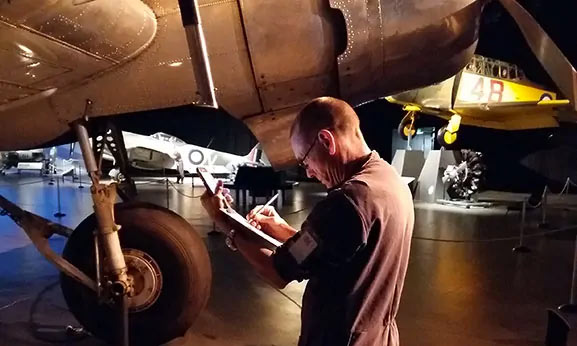Conserve
Akoranga whakauka waka rererangi
Large Object Conservation
In accordance with universal museum best practice, our policy is to preserve all collection items in the state in which they came to us (ie. ‘original’ condition). We do this by maintaining the best possible physical conditions, and not undertaking any form of intervention or non-reversible treatment.
For the majority of our Collection, this simply means stabilising the item by carefully removing any excess dust, dirt or mould, housing it in an acid-free box or custom enclosure, and storing it in a temperature and humidity-controlled environment. Access to our collection stores is strictly controlled to ensure the long-term security and preservation of the artefacts in our collection.
The attempt to slow the extent of physical deterioration as much as possible for as long as possible does not always sit comfortably with large objects, such as aircraft, aircraft structures, vehicles and engines. There is almost always a need to protect the object from further deterioration by applying reversible treatments such as corrosion preventative compounds.
Due to the age of many of our large objects, there is often some evidence of corrosion, or there may be some structural damage. This will require more invasive corrective measures to address the issue, though our approach is always one of minimum intervention. Original material will be used in preference to new unless there is a question of structural integrity or safety of the object.

Current Projects
- Vickers Vildebeest Mk.III
Find out about one of our most exciting historic aircraft rebuilds a Vickers Vildebeest biplane from the RNZAF’s earliest days. - Tasker ‘Queen Mary’ Trailer
This 3-tonne semi-trailer was designed and built in Britain by Tasker Trailers specifically for the recovery of aircraft parts and wreckage. It is being restored to its original condition while in service with the RNZAF.
Frequently Asked Questions
What is preservation?
Preservation is the most straightforward approach we use in caring for our artefacts, and should always be the first option. It involves housing and maintaining them in the best possible physical conditions which control humidity, temperature, light, pest threats, and atmospheric pollution, without any form of intervention or treatment. Regular assessments are important to monitor deterioration to determine if intervention is required.
What is the difference between restoration and conservation?
Conservation activities are carried out to protect an artefact from further deterioration by the application of reversible treatments, such as wax and other chemical barriers, and corrosion inhibiting compounds. These treatments should, wherever possible, be reversible so it does not change the appearance or physical integrity of the artefact.
Restoration is an invasive approach. For large objects such as aircraft and vehicles, it is adopted if structural integrity or safety is compromised and requires new (ie. non-original) components to be fitted. Original material that is replaced is still retained for historical purposes.
Why don’t we have any current restoration projects?
While historically, the Museum has engaged in major restoration projects, the P-40 Kittyhawk and Airspeed Oxford being the most recently completed examples, we are not pursuing any other aircraft restorations for the foreseeable future. This is so that we can focus on other development priorities, as well as maintaining and conserving our existing collection.
Why haven’t we restored any aircraft to flying condition?
The Museum’s policy is not to restore any of the aircraft in our collection so that they can fly. Our restoration approach for aircraft is to retain as much original material as possible to preserve their historical value and integrity. Many of the aircraft are unique and would be put at risk of damage or destruction by flying them. In order to make an aircraft airworthy, it often requires extensive replacement of structures and components.
What are the main risks to aircraft housed in museum collections?
The biggest risk is various forms of corrosion. A lot of older metal aircraft that are no longer flying have this, and those housed in museum collections are generally no different. When moving an aircraft there is always a risk of damage and we are required to do so for some of the aircraft in the Aircraft Hall when functions are scheduled. We have a well-developed procedure for this to minimise risk.
For more information on our large object conservation work, please contact us.



